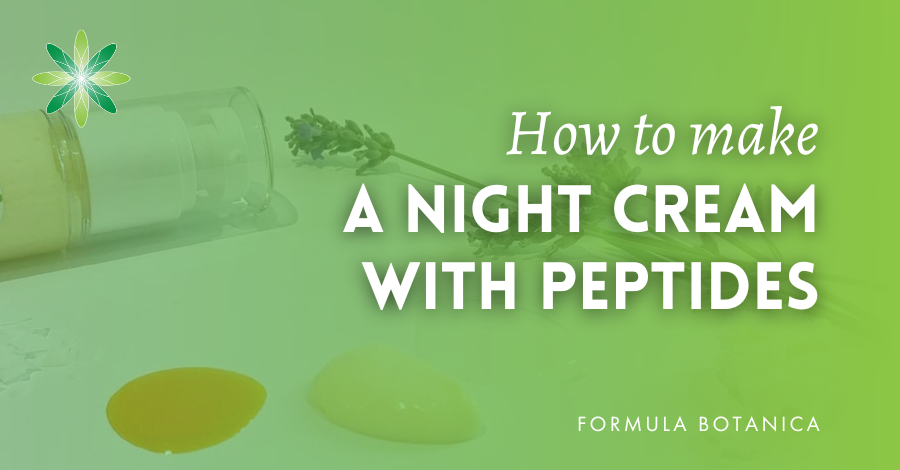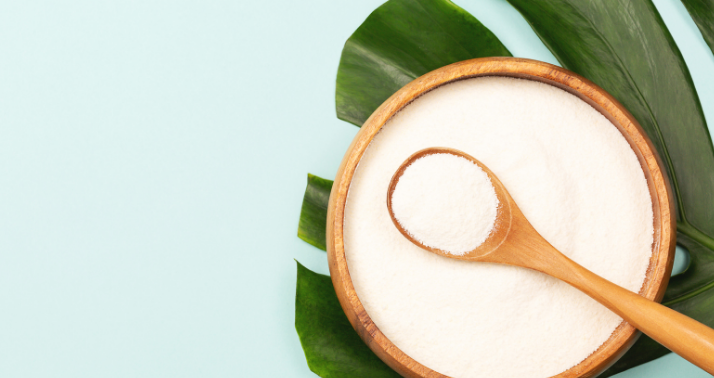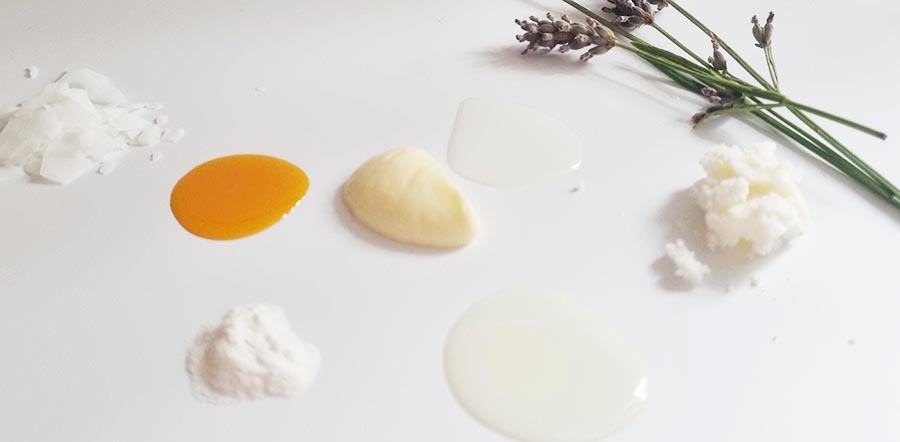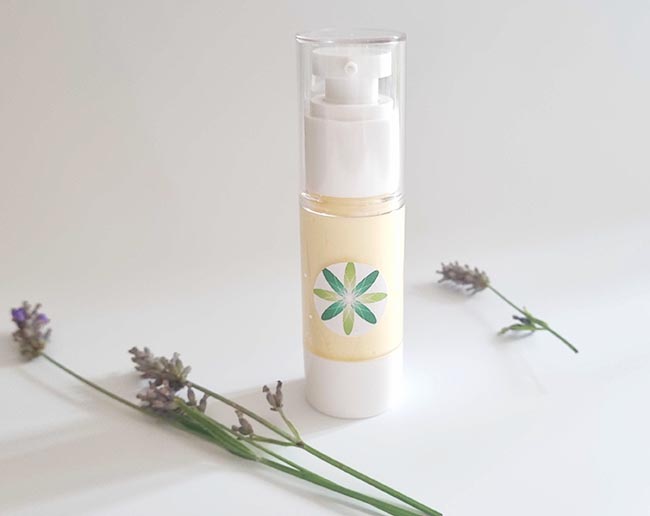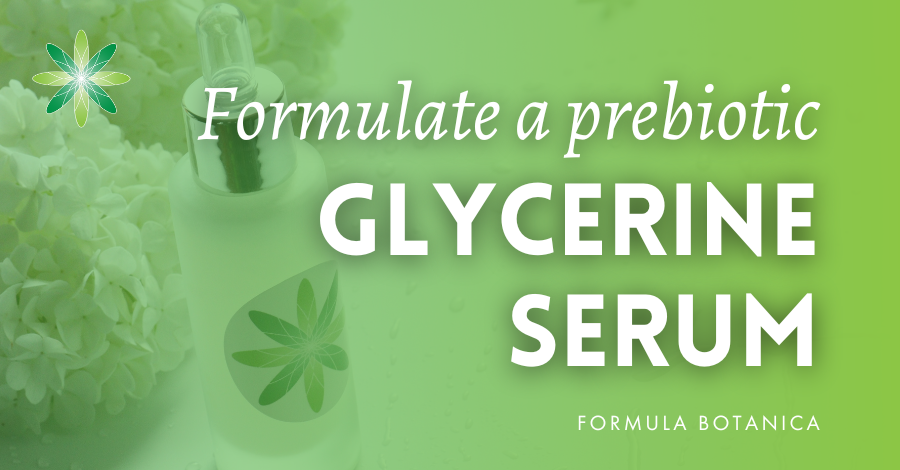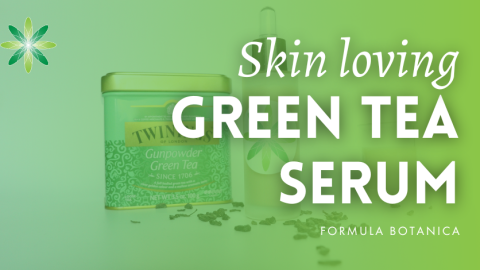In the past, so-called ‘anti-ageing’ skincare products were used in an attempt to reverse the signs of ageing and grasp onto a youthful appearance. As wonderful as many high-performance cosmetic ingredients are, they cannot work miracles. Ageing is an inevitable part of life. This is something the American writer Betty Frieden was well aware of when she said that ageing is not lost youth, but a new stage of opportunity and strength.
In the pandemic years in which we wore less makeup, consumers shifted their attention away from desiring to look and feel young to wanting to look and feel healthy. This encouraged cosmetic companies to promote healthy ageing and focus on products that impart, for example, radiance, a healthy glow and freshness to the skin.
Our formulation here is for a night cream and uses peptides as hero ingredients, along with rosehip and evening primrose oils, to help replenish the skin while you rest and promote nourished, healthy-looking skin.
To make a face cream, you need the cosmetic formulation skills to make an emulsion, but our step-by-step instructions guide you easily through the process.
What happens to skin as we age?
Many changes occur as we age; processes such as cell turnover and desquamation slow down and continue their gradual decline. The production of collagen is reduced and eventually the epidermis begins to thin. Degradation processes cause a further decline in the production of collagen and elastin. Hyaluronic acid and lipid production is also reduced.
Other factors alongside natural ageing can contribute to this process and even trigger premature ageing. Extrinsic factors affecting skin ageing include our lifestyle choices (for instance, smoking is said to have a detrimental impact on the skin), and exposure to UV radiation which has been shown to have a negative effect on the skin leading to the occurrence of age spots and uneven pigmentation.
As a result, structural changes like sagging and wrinkles become more visible and can sometimes cause the skin to look worn out. Our aim when creating skincare products is to make us feel and look more confident, healthy and happy with ourselves regardless of our age.
Why use peptides in skincare?
There are a plethora of ingredients that work excellently in products aimed at enhancing the appearance of the skin, however peptides are widely recognised as some of the best ingredients to formulate healthy-ageing skincare products with.
They are short chains of amino acids which are the building blocks of proteins like collagen, elastin and keratin which are made in our skin. Peptide technology is frequently used in skincare as it penetrates the skin and binds to cell surface receptors to stimulate cell activity. As we mentioned earlier, many processes, such as the production of these proteins, gradually slow with age. When applied topically, peptides can encourage the production of collagen and elastin which are so important for the structure, firmness and elasticity of the skin.
If you would like to find out more about peptides, their structure, and use in cosmetics, see The formulator’s guide to natural peptides.
Our exclusive members-only site The Lab at Formula Botanica dedicates an entire training module to peptides. If you’d like to access the Peptides Mini Lab, find out when we next open our doors for membership by pre-enroling for updates.
Peptides need support
There is no single ingredient that can turn back time. As brilliant as peptides are, they can’t do all the work on their own. For this reason, it is important to remember the saying “teamwork makes the dream work”. Peptides need other ingredients like antioxidants and skin-repairing ingredients to support them. Together, they are stronger and more likely to work towards the common goal of making the skin look and feel healthier. For this reason, we have carefully selected the following ingredients for our peptide face cream formulation.
Our ingredients for a peptide face cream
FSS Hexapeptide 1
This peptide ingredient is isolated from the fermentation of Saccharomyces cerevisiae which is a single-celled yeast organism. Although it was thought to be a very simple organism, it seems to have developed a series of mechanisms to protect itself from oxidative stress and extreme temperature conditions.
Yeast isolates have been known to be used for their anti-irritant properties and have also been shown to increase intracellular respiration and improve intracellular metabolism. FSS Hexapeptide 1 (see our list of suggested suppliers below) is used in natural skincare products and is a peptide that has a six amino acid sequence. These types of peptides are used to improve skin hydration, stimulate collagen and elastin synthesis and to reduce the visible signs of wrinkles, dark spots and eye puffiness.
FSS Amaranthus squalane
Squalene and squalane are produced in the body and are natural constituents of human sebum, and are some of the many lipids the body produces to moisturise and protect the skin. As we age, our natural production of squalene slows down significantly. Fortunately, we can obtain a sustainable, plant-based alternative to squalene which is highly stable against oxidation. FSS Amaranthus Squalane (see our list of suggested suppliers below) is intended to replace the squalane/squalene that is lost over time causing our skin to become dry and irritated. It may be used as a moisturiser in various cosmetic applications to promote skin renewal and repair.
Evening primrose oil
This belongs to the group of oils with a high linoleic acid content and the topical application of it is usually recommended for dry, mature and sensitive skin. Evening primrose oil has moisture-retaining properties and helps to prevent the skin from drying out and also soothes inflammation. It is said to have skin-rejuvenating and -healing properties in addition to improving the appearance of wrinkles. Evening primrose oil is known to go rancid quite quickly so we recommended using an antioxidant with it.
Rosehip oil
Rosehip oil is said to be a good choice for mature skin and acne-prone skin. It is also recommended for the treatment of irritated, inflamed and allergy-prone skin. Studies have shown that after dermal use there was increased synthesis of collagen and decreased inflammation. This oil has a high content of (E)-Retinoic acid; a vitamin A derivative which renders the oil quite unstable. We need therefore to incorporate it with more stable oils and antioxidants.
Our formulation: face cream with peptides
Our formulation is for a light, but nourishing face cream with peptides and enriching botanical oils and is lightly scented with lavender and rosemary. It is an ideal face cream to use at night after cleansing so the hero ingredients can really go to work in helping replenish mature and/or dry skin.
Makes: recommended batch sizes 50g/100g.
Time taken: 45 minutes.
Level: intermediate/advanced-level formulation.
| Phase | Ingredients | INCI | Weight (g) |
| A | Water | Aqua | 62.30 |
| B1 | Jojoba oil | Simmondsia chinensis seed oil | 6.00 |
| B2 | Argan oil | Argania spinosa kernel oil | 5.00 |
| B3 | Rice bran oil | Oryza sativa bran oil | 3.00 |
| B4 | Olivoil emulsifier | Potassium olivoyl hydrolyzed oat protein, Cetearyl alcohol, Glyceryl stearate, Aqua, Glyceryl oleate, Potassium sorbate, Sodium benzoate, Benzyl alcohol | 3.00 |
| B5 | Shea butter (unrefined) | Butyrospermum parkii butter | 2.00 |
| C1 | Vegetable Glycerine | Glycerin | 2.00 |
| C2 | Preservative Eco | Benzyl alcohol, Salicylic acid, Glycerin, Sorbic acid | 1.00 |
| C3 | Xanthan gum powder | Xanthan gum | 0.20 |
| D1 | Aloe vera juice | Aloe barbadensis leaf juice, Citric acid, Potassium sorbate, Sodium benzoate | 5.00 |
| D2 | FSS Hexapeptide 1* | Aqua, Hexapeptide-11, Leuconostoc/Radish root ferment filtrate | 3.00 |
| E1 | Kukui nut oil | Aleurites moluccanus seed oil | 3.00 |
| E2 | Evening primrose oil | Oenothera biennis oil | 1.00 |
| E3 | Rosehip oil | Rosa canina fruit oil | 1.00 |
| E4 | FSS Amaranthus squalane* | Squalane | 1.00 |
| E5 | High-strength vitamin E | Tocopherol, Helianthus annuus seed oil | 1.00 |
| E6 | Lavender true essential oil | Lavandula angustifolia oil | 0.30 |
| E7 | Rosemary oil | Rosmarinus officinalis leaf oil | 0.20 |
| Total: 100.00 |
*See our suggested suppliers below for these ingredients. However, similar are available widely from other suppliers.
Equipment
- Water bath
- Weighing scale
- Beakers
- Glass rods
- Spatulas
- Mini hand whisk and/or high shear mixer
- Thermometer/temperature gun
- pH strips/meter
Method of Manufacture: make a face cream
- Phase A
Weigh out phase A and place beaker into a water bath and heat to 75-80°C.
- Phase B
In a separate beaker, weigh out phase B and heat to 75-80°C until everything has melted and combined.
- Phase C
In a separate beaker, weigh out C1, add C2 and mix using a glass rod and then add C3 and mix again using glass rod. Set beaker to one side.
- Phase D
In a separate beaker, weigh out phase D and leave to one side.
- Phase E
In a separate beaker, weigh out phase E, mix with a glass rod and leave to the side.
- Emulsion making: stage 1
When phase B has melted and phase A is an equal temperature, pour the beaker of phase B, the oils and emulsifier, in the water phase A. Keep the beaker in the water bath for one minute while mixing using a hand-held manual whisk. Take the beaker out and continue mixing. Then place the beaker in some cold water and continue mixing with a hand whisk. This may take some time to blend and emulsify, but you will get there. Alternatively, if you have access to a high–shear mixer, you can place the beaker under high shear for 30 seconds.
- Emulsion making: stage 2
When the mixture of phase AB has cooled below 40°C, add in the gum mixture (phase C), mix in with the mini hand whisk and again, if you have access to a high-shear mixer, shear for 15 seconds.
- Phase D
Into the mixture of phase ABC, add the beaker containing phase D and mix using the mini whisk until there is no phase D liquid visible.
- Phase E
Into the mixture of phase ABCD, add the beaker containing phase E and mix using the mini whisk until there is no visible liquid. If using a high-shear mixer, shear for a further 30 seconds. Please note, the cream is likely to thicken a little more after 24 hours.
- Test pH
Take a sample of the cream and test the pH, we are aiming for a pH of 5 to 5.5. If it is any more or any less, adjust accordingly.
- Bottle and label
Transfer into your chosen bottle and label with product name, date and batch. Your cream needs 24 to set to its final viscosity.
Suggested suppliers
Formulator Sample Shop (EU) and Formulator Sample Shop (US) for our chosen peptides.
Bay House Aromatics (UK/EU)
Alexmo-Cosmetics (Europe/UK)
Mystic Moments (UK/worldwide)
Forest Wise (ethically-sourced rainforest butters and oils)
FREE TRAINING
Learn how to become an
Organic Skincare Formulator
FREE TRAINING
How to become an
Organic Skincare Entrepreneur
FREE TRAINING
How to become an
Organic Skincare Entrepreneur
Leave us a comment

Rouah was a member of the Formula Botanica team between 2020-2022. Rouah is a cosmetic chemist with many years’ experience as a formulator, product and project manager and scientific advisor in the cosmetic industry. Passionate about understanding the science behind raw ingredients, Rouah also has a deep interest in wellbeing, sustainable action, and social influence.

